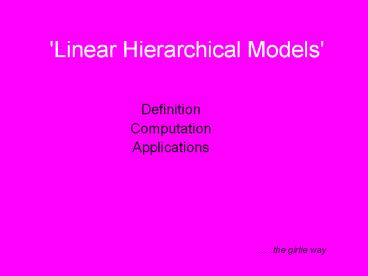Linear Hierarchical Models - PowerPoint PPT Presentation
Title: Linear Hierarchical Models
1
'Linear Hierarchical Models'
- Definition
- Computation
- Applications
the girlie way
2
Definition
Hierarchical models provide a framework for
both Classical inference (at first second
level) Parametric Empirical Bayes (PEB) at
first level (constrained by higher
levels). Extension of the general linear model
but with more variance components.
Computation
Both Classical and Bayesian approaches rest on
estimating the covariance
components
Covariance components refer to the multiple
variance components in the data
(including
within between subject variance) Covariance
components estimation is based on Maximum
Likelihood estimator (ML) or the Expectation
Maximization (EM) algorithm
ML plus expectation step.
3
- y response variable
- X design matrix/explanatory variables
- parameters (betas) e error
1st Level Activation over scans
(within session subject) 2nd Level
Activation over sessions (within
subjects) 3rd Level Subject specific effects
(over subjects)
Parameters (q ) Quantities that determine the
expected response (the effect)
Can be estimated from mean without knowing
its variance Hyperparameters Variance of these
quantities (within between subject)
(classically estimated using
residual sum of squares)
4
Classical approach how large are parameters
with respect to standard error inference
usually made at highest level (using between
subject variability).
Bayesian inference probability of the
parameters given the data prior covariance
error covariance at level above i.e. inference at
lower levels (constrained by higher levels)
e.g. Estimate of single subject can be
constrained by knowledge of population using
between subject variability from 2nd level as
priors for parameters at first level.
SPM uses activation over voxels (within subject)
as the priors
E.g. Within subject 1st Level Activation over
scans 2nd Level Activation over voxels
Both Classical and Bayesian approaches rest on
estimating the covariance components
5
Covariance component estimation
estimating hyperparameters (within between
subject contributions to error)
(hierarchically organised linearly mixed
variance components)
Flattened to
Variance components are estimated with
Expectation Maximization (EM) Algorithm
6
Expectation Maximization (EM) Algorithm
EM estimates both parameters and hyperparameters
from the data (using generic
iterative / re-estimation procedure)
E. step finds expectation covariance of the
parameters holding hyperparameters
fixed.
M. step updates maximum likelihood estimate of
hyperparameters holding parameters
fixed.
EM used when hyperparameters of the likelihood
and prior densities are not known. these
hyperparameters become variance components that
can be estimated using
restricted maximum likelihood (ReML)
ReML involves M step but not E step finds unknown
variance components without explicit reference to
the parameters.
over to Raj































